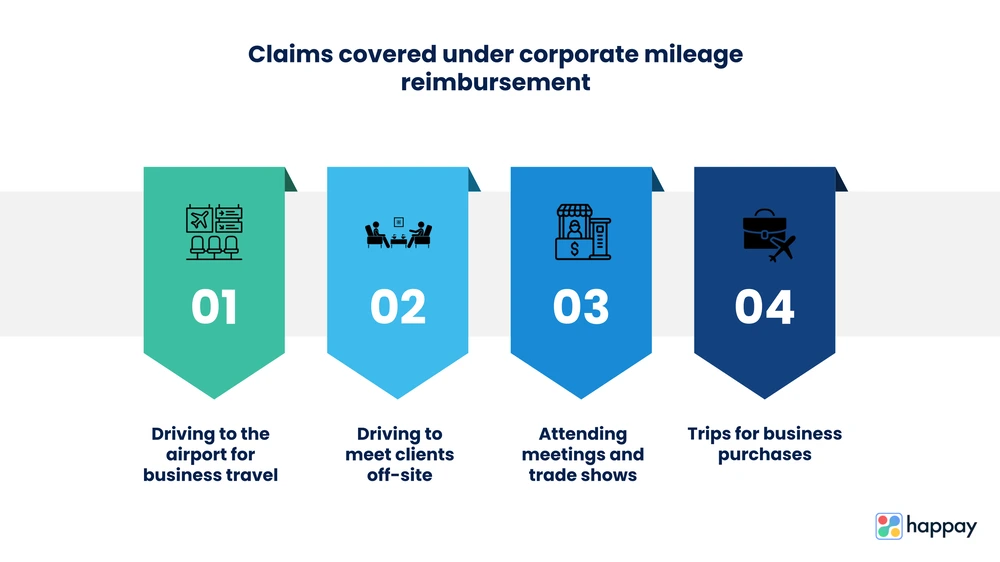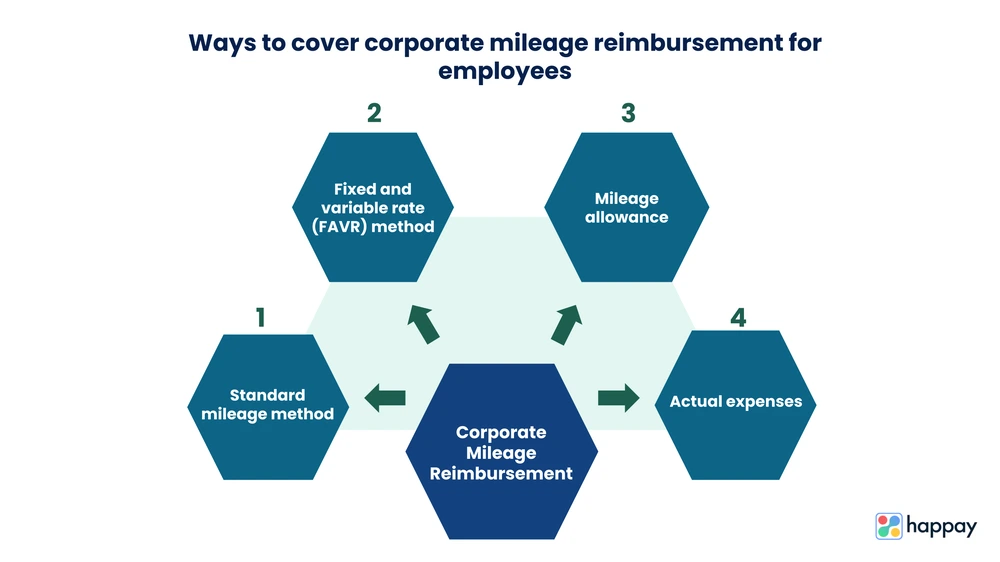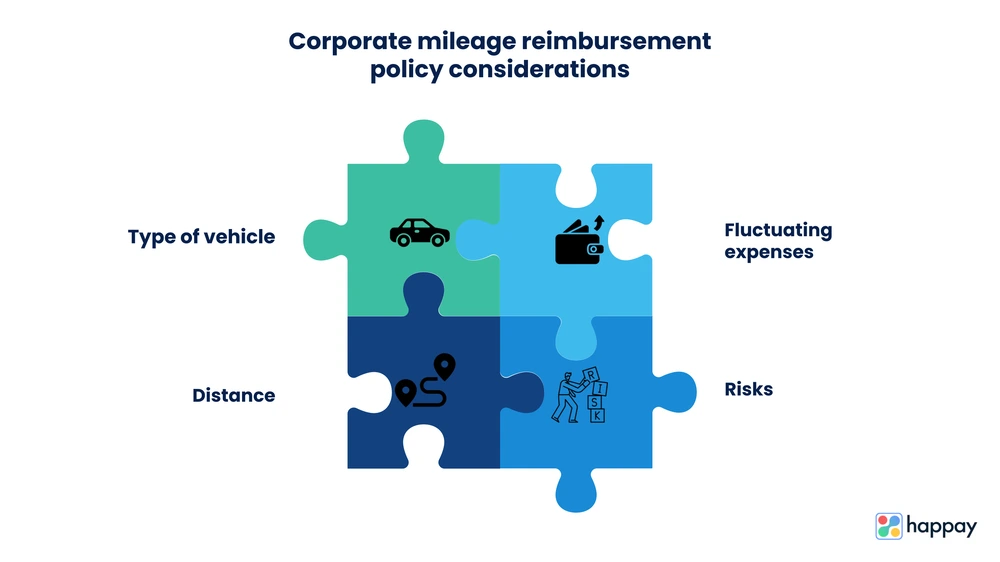Last Updated on November 28, 2025
Mileage for travel
As an important business decision-maker, you must fully understand the importance of optimizing every aspect of your company’s operations, including employee reimbursement programs. If you have a large team of employees who frequently travel for work-related reasons, understanding ways to get the most out of your company’s travel and mileage reimbursement program can thus be a game-changer.
Rising fuel costs and complex IRS regulations may further complicate things, making it necessary to have a solid plan to ensure your employees are fairly compensated while keeping costs under control.
This guide offers a comprehensive view of the topic to help you streamline your reimbursement process and boost overall profitability. We will look at everything from calculating reimbursement rates to implementing best practices for tracking and managing expenses and improving employee satisfaction.
Also, Read: A Guide to Corporate Travel Management
What is mileage reimbursement?
Mileage reimbursement is a common practice where employers compensate their employees for expenses like cost of fuel incurred while driving on behalf of the business. Usually, mileage reimbursement is calculated per mile, typically below $1 per mile.
However, mileage expense reimbursement rates can vary based on IRS regulations and state laws. You must ensure your reimbursement program complies with applicable regulations to avoid potential legal issues.
Understanding corporate mileage reimbursement
Mileage reimbursement is an employee benefit where an employer compensates employees for using their own vehicles for business purposes. The compensation calculation works on the number of miles driven and the current Internal Revenue Service (IRS) mileage rate (updated annually).
For example, let’s say an employee drove their car 100 miles for business purposes at $0.655 per mile, the current IRS rate for 2023. The employer would reimburse the employee $65.5 (100 miles x $0.655 per mile).
Mileage reimbursement benefit is essential for employees who regularly use their personal vehicle for business travel. It can help offset the cost of wear and tear on their vehicle and ensure they are fairly compensated for their work-related expenses.
Suggested Read: 10 Best Expense Reimbursement Software
How does corporate mileage reimbursement work?
To qualify for mileage reimbursement, an employee must drive on behalf of the company and keep accurate records of their business mileage and related expenses. It can include fuel costs, maintenance and repairs, insurance, and vehicle depreciation.
The reimbursement rate may vary depending on the employer’s travel policy, vehicle type, and the state in which the employee is driving. Some employers may opt for a flat monthly rate instead of a per-mile rate, which can simplify the reimbursement process.
To receive reimbursement, employees typically submit mileage log or odometer readings to their employer, including the travel dates, starting and ending locations, and the number of miles driven. The employer then verifies the report and issues a reimbursement check or direct deposit.
Quick Read: A Guide to Travel Policy for Employees in India
Claims covered under corporate mileage reimbursement
Some typical mileage claims covered under a corporate mileage reimbursement program can include the following:

1. Driving to the airport for business travel
Employees who travel by air for business may need to drive their vehicles to the airport. Mileage reimbursement can cover the expenses related to this travel, such as fuel costs and parking fees.
2. Driving to meet clients off-site
Employees needing to meet a client or customer off-site may use their vehicle. Mileage reimbursement can cover the fuel and meal costs associated with this travel.
3. Attending meetings and trade shows
Employees who attend meetings, trade shows, or seminars on behalf of the company may use their vehicle to get there. Mileage reimbursement can cover the cost of gas, parking fees, and other expenses related to this trip.
4. Trips for business purchases
Employees needing to travel to purchase supplies or equipment for business may use their vehicle to get there. Mileage reimbursement can cover the cost of gas and other expenses related to this trip.
Also, Read: A Guide to Expense Reimbursement Claims
Employer obligations for corporate mileage reimbursement
Employers have certain obligations when providing mileage reimbursement to their employees. These obligations ensure employees are fairly compensated for the expenses of using their vehicles for business purposes.
Some of the key employer obligations for mileage reimbursement include:
1. Establishing a reimbursement policy: A clear policy must outline the reimbursement rate, the types of expenses covered, and the procedures for submitting reimbursement claims.
2. Maintaining accurate records: Employers must maintain accurate records of all mileage reimbursement payments made to employees.
3. Complying with IRS regulations: The IRS provides guidelines to employers for calculating the reimbursement rate and maintaining adequate records.
4. Providing timely reimbursement: Reimbursement should be made within a reasonable time frame, typically within 30 days of submitting a reimbursement amount claim.
5. Providing adequate training and support: Adequate training and support can include guiding record-keeping, reimbursement rates, and the reimbursement process.
Also, Read: How to Create a Corporate Travel Policy?
Importance of corporate mileage reimbursement for employers
Providing mileage reimbursement is an important aspect of an employer’s responsibility to their employees. While there is no federal requirement for US employers, some states have their own requirements, making it essential for employers to comply with applicable state laws.
Failing to provide adequate mileage reimbursement can have the following consequences for employers:
- Harmed employee morale
- High employee turnover rates
- Legal consequences like lawsuits and penalties
Mileage reimbursement can help employers attract and retain top talent as they can demonstrate their commitment to supporting their employees and promoting a positive work environment.
Quick Read: Why Does Your Business Need a Corporate Travel Program?
Ways to cover corporate mileage reimbursement for employees
Employers can cover mileage reimbursement for their employees in the following ways.

1. Standard mileage method
Employers can reimburse employees based on the miles driven for business purposes as a cents-per-mile rate approach offers a clear and concise methodology that doesn’t leave room for doubt.
2. Fixed and variable rate (FAVR) method
It covers fixed and variable costs incurred by an employee when using their personal vehicle for business. Fixed expenses include insurance, registration, and depreciation, while variable costs include fuel charges and maintenance.
3. Mileage allowance
It is a set amount of money paid to employees for each month. This amount can vary depending on the company’s policy and state regulations. For example, an employee can receive a $655 monthly allowance for 1000 miles. Employers can adjust the excess or less amount in the subsequent month’s allowance report.
4. Actual expenses
It requires employees to keep track of all expenses related to their vehicle and submit receipts for reimbursement. While this method can be more time-consuming for the employer and the employee, it ensures that the employee is fully reimbursed for all expenses.
Also, Read: A Guide to Travel Expense Reimbursement Process
Corporate mileage reimbursement calculation methodology
Employers can use a standard framework to determine how much to reimburse their employees. The mileage reimbursement calculation is possible in several ways, depending on the applicable state laws. One common method is the standard mileage rate set by the IRS. It offers a straightforward method for employers to use.
Employers can also set their mileage reimbursement figures. However, there’s a possibility of losing out on tax deduction benefits if it exceeds the standard mileage rate, as the excess amount will count as regular wages. Thus, employers must consider the tax implications when setting their mileage reimbursement calculation rate.
Mileage reimbursement for independent contractors
Independent contractors are not on the company payroll and are considered self-employed. However, they are still entitled to reimbursement for using their vehicle for business purposes.
Self-employed individuals can claim the same mileage reimbursement rate as employees. They can claim this rate for all business miles driven, whether for meeting clients or attending business events.
Besides mileage reimbursement, self-employed individuals can claim other expenses like tolls, parking fees, and maintenance. However, they must maintain accurate records and receipts of the expenses to claim them.
Recommended Read: How to Make Travel Checklist for Executive Assistants?
Corporate mileage reimbursement policy considerations
When framing a mileage reimbursement policy, here are some considerations to adopt to ensure the policy is fair, reasonable, and compliant with applicable laws.

1. Type of vehicle
It would be best to differentiate between personal and company-owned vehicles and set different reimbursement rates accordingly. Additionally, you can set the standard for the age, condition, and safety features of personal vehicles used for business purposes.
2. Distance
Encouraging employees to take the most efficient routes to minimize mileage and associated costs would be best. Furthermore, setting the maximum travel distance for employees will allow you to decrease the rate and require additional approvals. It will control costs and ensure business travel is limited to essential trips.
You may also want to establish predetermined routes. For example, you may establish fixed routes for service calls. The reimbursement rate can be set based on the predetermined distance and route.
3. Fluctuating expenses
Fuel cost changes should be considered when framing a mileage reimbursement policy. You should periodically review and adjust the reimbursement rates to reflect changes in this expense.
4. Risks
It may include liability issues, insurance requirements, and safety concerns. Employers should ensure their policies and procedures comply with regulations to protect the company and its employees.
Suggested Read: How to Create an Expense Reimbursement Policy?
Corporate mileage reimbursement and brand image
A clear and fair reimbursement policy shows the company values its employees and their work. Employees who feel valued and fairly compensated for their expenses are more likely to be engaged and motivated.
A mileage reimbursement policy also demonstrates that the company is responsible and compliant with regulations. In some states, employers must legally reimburse employees for business-related driving expenses. Failure to comply with these regulations can result in legal and financial consequences and reputational damage.
A well-designed mileage reimbursement policy can help control costs and ensure the company’s resources are used effectively. The company can avoid unnecessary expenses and ensure that business travel is limited to essential trips.
Lastly, a transparent mileage reimbursement policy builds trust and credibility with customers, suppliers, and other stakeholders. Businesses can enhance their reputation and brand image by demonstrating integrity and fairness.
Leveraging Happay’s automation solutions for mileage expense management
Happay offers cutting-edge automation tools for managing mileage expenses holistically. Your business can enjoy several benefits that help streamline its expense management process, reduce costs, and improve compliance. Let’s look at them in detail.
1. Travel and expense cost control
Happay’s automated systems can track and monitor all travel expenses, allowing you to identify areas to reduce costs and save money. For example, pre-trip planning and approvals ensure no unauthorized travel.
2. Compliance automation
Manual tracking and reporting can be time-consuming and error-prone. Happay’s automated system ensures compliance by automating tracking mileage and expenses, enforcing policies, and flagging potential compliance issues.
3. Accelerated completion of expense reports
If done manually, it can take significant time and effort to complete expense reports. Happay streamlines the process of completing reports swiftly and with complete accuracy. It will free up valuable time for employees and allow them to focus on more critical tasks.
4. Real-time insights
Get real-time insights that allow you to make informed decisions quickly with Happay Analytics. Travel and mileage reimbursement information can identify trends, track expenses, and adjust policies. For example, if a particular employee consistently spends more on travel than others, you can use this information to identify issues and take corrective steps.
Bottom line
Managing corporate mileage reimbursement can be a time-consuming task. However, you can streamline the travel and mileage reimbursement process, reduce errors, and save time and money with the right approach and tools.
Automating the process can bring numerous benefits, including better control over travel and expense costs, compliance with tax and accounting regulations, and real-time insights into travel spending. Your teams can simplify the process and focus on more critical tasks, ultimately driving productivity and profitability for your business.
FAQs
Follow these steps to calculate mileage for travel:
a) Identify the starting point and destination of the travel.
b) Check the route taken for the trip with the help of a map or GPS.
c) Use a mileage tracking tool or app to calculate the distance traveled.
d) Multiply the total distance traveled by the reimbursement rate per mile. The reimbursement rate may vary depending on state laws.
For example, if someone traveled 100 miles and the reimbursement rate is $0.655 per mile, the calculation would be 100 miles x $0.655 per mile = $65.50. Therefore, the travel reimbursement is $65.50.
The cost of one mile varies depending on the reimbursement rate of the state laws. For example, if the reimbursement rate is $0.655 per mile, the cost of one mile is $0.655. You can multiply the distance by the reimbursement rate to calculate the reimbursement for a specific distance.
For example, if you traveled 50 miles for business and the reimbursement rate is $0.655 per mile, the calculation would be: 50 miles x $0.655 per mile = $32.75.
The mileage rule is the standard rate the Internal Revenue Service (IRS) sets for business-related mileage expense calculations. The IRS sets the standard mileage rate each year based on studying the fixed and variable automobile operating costs. It includes factors like fuel costs, depreciation, and maintenance expenses.
Mileage reimbursement is compensation offered by an employer to an employee for the expenses incurred while using their personal vehicle for business-related purposes. This reimbursement covers fuel, maintenance, insurance, and depreciation expenses.
Mileage for travel, or mileage reimbursement, can offer the following benefits to both employees and employers:
a) Cost savings
b) Fair compensation
c) Increased productivity
d) Improved record-keeping
e) Reduced liability










Discussion about this post